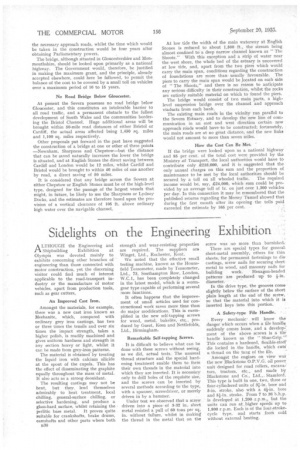Sidelights on the Engineering Exhibition
Page 48

If you've noticed an error in this article please click here to report it so we can fix it.
A LTHOUGH the Engineering and /-1 Shipbuilding Exhibition at Olympia was devoted mainly to exhibits concerning other branches of engineering than those connected with motor construction, yet the discerning visitor could find much of interest applicable to the road-transport industry or the manufacture of motor vehicles, apart from production tools, such as gear cutters, An Improved Cast Iron.
Amongst the materials, for example, .there was a new cast iron known as Meehanite, which, compared with ordinary grey iron castings, has two or three times the tensile and over six times the impact strength, takes a higher polish, is readily machined and gives uniform hardness and strength in any section heavy or light, whilst it can be made from grey-iron patterns.
The material is obtained by treating the liquid iron with calcium suicide at the spout of the cupola. This has the effect of disseminating the graphite equally throughout the mass of metal. It also acts as a strong deoxidant.
The resulting castings may not be bent, but they, lend themselves admirably to heat treatment, local chilling, general-surface chilling, or selective hardening, and produce a glass-hard surface, whilst retaining the perlitic base metal. It proves quite suitable for crankshafts, brake drums, camshafts and other parts where both 330 strength and wear-resisting properties are required. The suppliers are Winget, Ltd., Rochester, Kent.
We noted that the effective small testing machine, known as the Hounsfield Tensometer, made by Tensometer, Ltd., 73, Southampton Row, London, W.C.1, has been completely changed in the latest model, which is a wormgear type capable of performing several more functions.
It often happens that the improvement of small articles used for constructional work saves more time than do major modifications. This is exemplified in the new self-tapping screws for wood, metal, bakelite, etc., produced by Guest, Keen and Nettlefolds, Ltd., Birmingham.
Remarkable Self-tapping Screws.
It is difficult to believe what can be done with these screws without seeing, as we did, actual tests. The unusual thread structure and the special hardening treatment enable them to form their own threads in the material into which they are inserted: It is necessary only to drill holes of the requisite size, and the screws can be inserted by several methods according to' the type, with a spanner, screwdriver, or merely driven in by a hammer.
Under test we observed that a screw driven into a piece of 3-32 in. sheet metal resisted a pull of 60 tons per sq, in. without 'failure, whilst in making the thread in the metal that on the screw was no more than burnished.
There are special types for generalsheet-metal assembly, others for thin sheets, for permanent fastenings to die. castings, screw nails for securing sheet metal to wood, and masonry nails for building work. Hexagon-headed patterns are produced up to diameter.
In the drive type, the grooves come slightly below the surface of the short plain length at the end of the screw, so that the material into which it is inserted keys into this portion.
A Safety-type File Handle.
Every mechanic' will know the' danger which occurs when a file handla suddenly comes loose, and a development of the above screws is a file handle known as the "Shur-Grip' This contains a hardened, flexible-steel' die locked in the handle, which cuts' a thread on the tang of the file.
Amongst the engines on view was the new Blackstone 0.P.V.G. oil power unit designed for road rollers, excavators, tractors, etc., and made by Blackstone and Co., Ltd.,. Stamford. This type is built in one, two, three or four-cylindered units of 31--in. bore and 5-in, stroke, also with a 4Fin. bore and 51-in. stroke. From 7 to 36 b.h,p. is developed at 1,200 r.p.m„ but the units can run at_ higher speeds up to 1,800 r.p.m. Each is of the four-strokecycle type, and starts from cold without external heating.




































































































